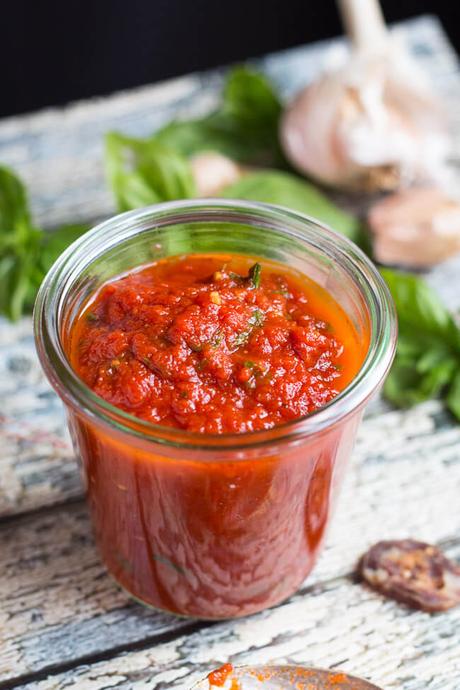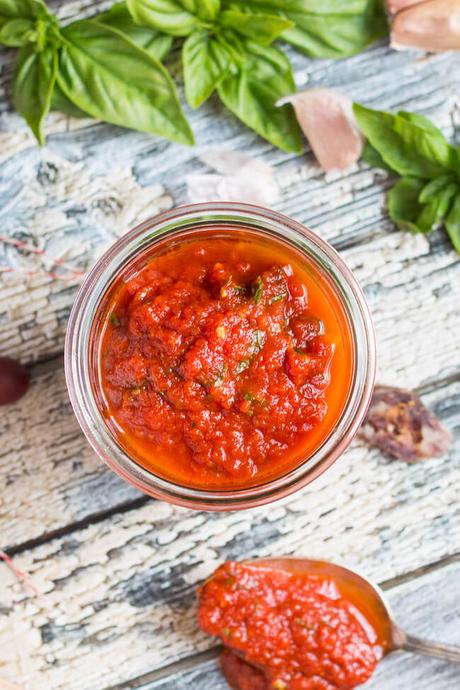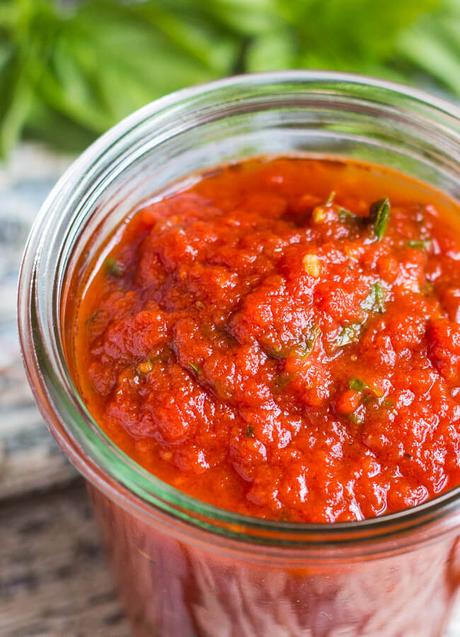Total Time Investment: 28 Minutes

Friday pizza nights are fast becoming a thing in our house. With a bucket of bread dough in the fridge, and a jar of the absolute best pizza sauce ( in my not so very humble opinion) in the fridge, we can have dinner on the table in far less time than it takes to order a pizza and go pick it up. And now that Mr Grumpy has mastered his new BBQ, the quality of the pizzas we make at home is far superior to those from our local take-away.
I've tried many different commercial pizza sauces over the years, and have never been really happy with any of them. So now I just make my own. It is cheaper, so simple to make, and tastes far better than anything I can buy in a jar.
I normally use a bottle of my homemade tomato sauce (passata) as the base for my easy pizza sauce. In a pinch I have pressed a a can of chopped tomatoes into service, although I have found that the sauce takes slightly longer to cook down to a spreadable consistency. Canned tomatoes still make a great sauce, so see my tips below if this is all you have on hand.

Keep the herbs and spices to a minimum, so as not to overpower any toppings on the pizza. I only use garlic, oregano, salt and pepper, with just a sprinkle of sugar to balance out the acidity of the tomatoes. The sugar is entirely optional, so leave it out if you prefer. If I make the sauce in summer, when basil is in season, I will stir through a handful of freshly chopped basil right at the end. I leave the basil out in winter as it is harder to get hold of.
The real delight in making your own pizza sauce is that you control the thickness of your sauce. If you like a thinner consistency, then simmer the pizza sauce for a shorter period of time. To make the pizza sauce thicker, just reduce the sauce for a little longer until your preferred consistency is reached.
The Best Pizza Sauce - How To Get Ahead
Once cooked, homemade pizza sauce will last for up to a week in the fridge. The reduction of water in the sauce, and the higher acidity of the tomatoes, increases the storage time. This means you can easily make the sauce on Sunday for a planned pizza night the following Friday.
The sauce also freezes extremely well, so I routinely make larger batches and stock the freezer for the future. I like to freeze the pizza sauce in one cup portions for a family pizza night, and I also use ice cube trays for individual stovetop pizzas through the week.

Ingredient Substitutions for The Best Pizza Sauce
Tomato sauce is known by many names, depending on where in the world you live. As far as I can determine, tomato sauce, tomato puree and tomato passata are all the same thing, and are the best base for pizza sauce. And by tomato sauce, I do not mean the sweet/sour sauce that Australians put on chips (for some inexplicable reason), and that is known as tomato ketchup in other parts of the world.
Tomatoes are the key ingredient in any pizza sauce, but don't let the lack of tomato sauce prevent you from making your own. I have made pizza sauce with tins of chopped tomatoes, and with chopped fresh tomatoes. I have also used tomato sauce with the herbs and spices already added in a pinch.
If fresh or tinned tomatoes are all that you have on hand, you have two options:
- puree the tomatoes, then proceed with the recipe below, or
- use the chopped tomatoes, adding a little water to the fry pan as well. The tomatoes will take a little longer to cook down but will still make a great sauce.
You could use a small amount of garlic powder in place of the fresh garlic. I haven't tried this myself as I always have fresh garlic on hand, but can see no reason why this wouldn't work.
Use dried marjoram or dried basil (or both) in place of the oregano. Chopped fresh parsley can be added to the sauce if you have it on hand.

Using The Best Pizza Sauce
Whilst pizza is the obvious choice for using your newly made sauce, I couldn't leave without giving you a few other ideas. Try using your freshly made sauce in the following recipes:
And lastly, if you ever find yourself without any pizza sauce, and no time to make some, then you can just spread a thin layer of tomato sauce (passata) straight out of the bottle over the base of your pizza before you add your toppings. I have personally resorted to this strategy many times, so can attest that it still makes a great pizza.

